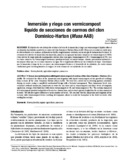| dc.contributor.author | Tremont, Omar | |
| dc.contributor.author | Mogollón, José P. | |
| dc.contributor.author | Martínez, Gustavo | |
| dc.date.accessioned | 2015-03-19T21:41:22Z | |
| dc.date.available | 2015-03-19T21:41:22Z | |
| dc.date.issued | 2006 | |
| dc.identifier | 471326 | es_ES |
| dc.identifier.issn | 1659-0082 | es_ES |
| dc.identifier.uri | https://repositorio.catie.ac.cr/handle/11554/6412 | |
| dc.description | 2 ilustraciones, 2 tabulaciones, 12 referencias | es_ES |
| dc.description.abstract | El objetivo de este trabajo fue evaluar el efecto de la inmersión y riego con vermicompost líquido sobre el crecimiento de plántulas a partir de secciones del clon Dominico-Hartón (Musa AAB). El ensayo se realizó en condiciones de vivero durante seis semanas, utilizando un diseño completamente aleatorio con un arreglo de tratamientos factorial. Se evaluaron tres niveles de inmersión (sin inmersión, inmersas en agua por una hora e inmersas en vermicompost al 100 por ciento) y tres niveles de riego aplicado en promedio cada tres días (con agua, vermicompost al 1 por ciento y vermicompost al 5 por ciento). Concluimos que la inmersión y riego de las secciones con vermicompost favorece el desarrollo de las plántulas, las cuales reúnen condiciones para ser transplantadas al campo a la sexta semana de ser sembradas las secciones. | es_ES |
| dc.description.abstract | We evaluated the effect of the immersion and irrigation with liquid vermicompost on the growth of seedlings from sections of the clone Dominico-Harton (Musa AAB). The trial was carried out in breeding ground conditions during six weeks, using a completely randomized design with a factorial arrangement. Three immersion levels were evaluated (without immersion, immersion in water for one hour and in vermicompost) and three levels of irrigation applied on average every third day (with water, vermicompost at 1 percent and vermicompost at 5 percent). The sections immersed in vermicompost sprouted and produced leaves in a shorter time, and reached a greater height than the sections immersed in water. We did not register differences in the number of leaves. We conclude that the immersion and irrigation of the sections with vermicompost favors seedling development, wich is ready for transplant to the field six weeks after sowing the sections. | en_EN |
| dc.format.mimetype | pdf | |
| dc.language.iso | es | es |
| dc.publisher | CATIE, Turrialba (Costa Rica) | es_ES |
| dc.relation.ispartof | Manejo Integrado de Plagas y Agroecología Número 77 (Abril 2006) | |
| dc.rights.uri | https://creativecommons.org/licenses/by-nc-nd/4.0/ | |
| dc.subject | MUSA (PLATANOS) | es_ES |
| dc.subject | EISENIA FOETIDA | es_ES |
| dc.subject | CLONES | es_ES |
| dc.subject | PLANTULAS | es_ES |
| dc.subject | COMPOST | es_ES |
| dc.subject | AGRICULTURA ORGANICA | es_ES |
| dc.subject | ANATOMIA DE LA PLANTA | es_ES |
| dc.title | Inmersión y riego con vermicompost líquido de secciones de cormos del clon Dominico-Harton (Musa AAB) | es_ES |
| dc.title.alternative | Inmersion and irrigation with liquid vermicompost of sections of the clone Dominico-Harton (Musa AAB) | es_ES |
| dc.type | Artículo | es_ES |
| dc.journal.issueNumber | 77 | |
| dc.journal.pages | 57-61 | |



